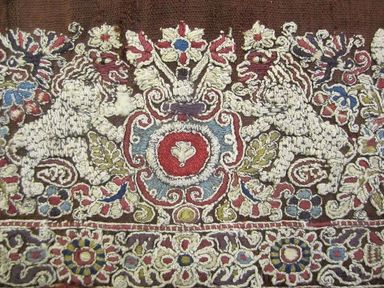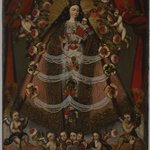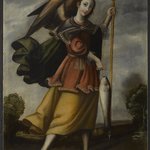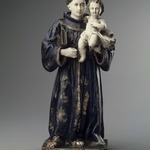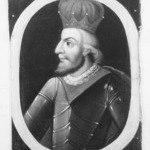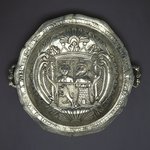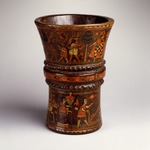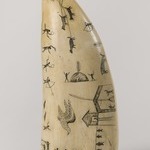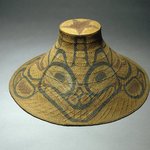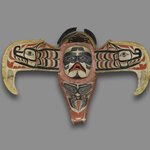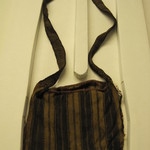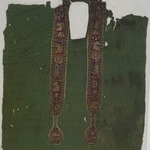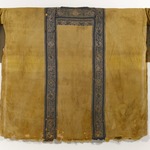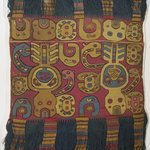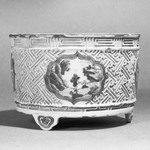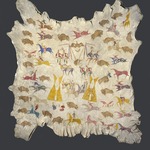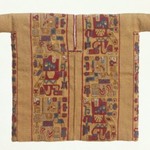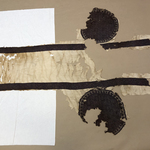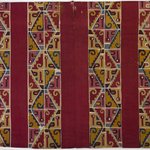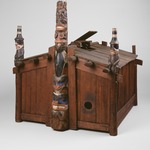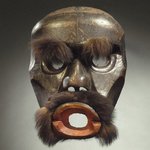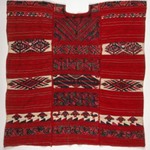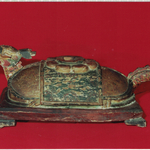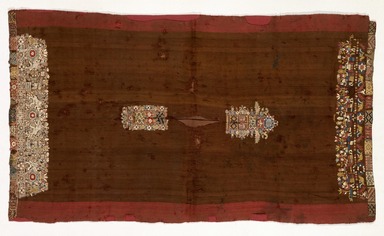

Tunic (Uncu), ca. 17th century. Camelid fiber, silk, metallic thread, 26 3/4 x 31 in. (67.9 x 78.7 cm). Brooklyn Museum, Gift of the Ernest Erickson Foundation, Inc., 86.224.51. Creative Commons-BY (Photo: Brooklyn Museum, 86.224.51_SL1.jpg)
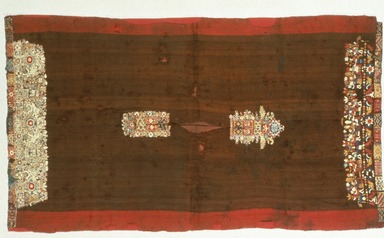
Tunic (Uncu), ca. 17th century. Camelid fiber, silk, metallic thread, 26 3/4 x 31 in. (67.9 x 78.7 cm). Brooklyn Museum, Gift of the Ernest Erickson Foundation, Inc., 86.224.51. Creative Commons-BY (Photo: Brooklyn Museum, 86.224.51_view2_SL1.jpg)
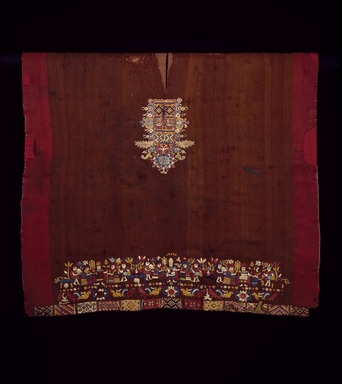
Tunic (Uncu), ca. 17th century. Camelid fiber, silk, metallic thread, 26 3/4 x 31 in. (67.9 x 78.7 cm). Brooklyn Museum, Gift of the Ernest Erickson Foundation, Inc., 86.224.51. Creative Commons-BY (Photo: Brooklyn Museum, 86.224.51_side1_SL3.jpg)
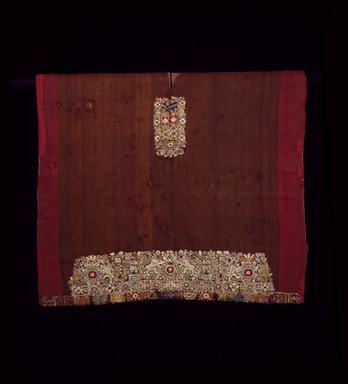
Tunic (Uncu), ca. 17th century. Camelid fiber, silk, metallic thread, 26 3/4 x 31 in. (67.9 x 78.7 cm). Brooklyn Museum, Gift of the Ernest Erickson Foundation, Inc., 86.224.51. Creative Commons-BY (Photo: Brooklyn Museum, 86.224.51_side2_SL3.jpg)
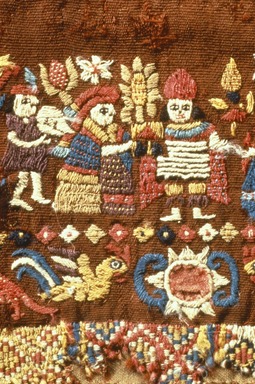
Tunic (Uncu), ca. 17th century. Camelid fiber, silk, metallic thread, 26 3/4 x 31 in. (67.9 x 78.7 cm). Brooklyn Museum, Gift of the Ernest Erickson Foundation, Inc., 86.224.51. Creative Commons-BY (Photo: Brooklyn Museum, 86.224.51_detail12A_SL1.jpg)

Tunic (Uncu), ca. 17th century. Camelid fiber, silk, metallic thread, 26 3/4 x 31 in. (67.9 x 78.7 cm). Brooklyn Museum, Gift of the Ernest Erickson Foundation, Inc., 86.224.51. Creative Commons-BY (Photo: Brooklyn Museum, 86.224.51_detail12B_SL1.jpg)

Tunic (Uncu), ca. 17th century. Camelid fiber, silk, metallic thread, 26 3/4 x 31 in. (67.9 x 78.7 cm). Brooklyn Museum, Gift of the Ernest Erickson Foundation, Inc., 86.224.51. Creative Commons-BY (Photo: Brooklyn Museum, 86.224.51_detail01_SL3.jpg)

Tunic (Uncu), ca. 17th century. Camelid fiber, silk, metallic thread, 26 3/4 x 31 in. (67.9 x 78.7 cm). Brooklyn Museum, Gift of the Ernest Erickson Foundation, Inc., 86.224.51. Creative Commons-BY (Photo: Brooklyn Museum, 86.224.51_detail02_SL3.jpg)

Tunic (Uncu), ca. 17th century. Camelid fiber, silk, metallic thread, 26 3/4 x 31 in. (67.9 x 78.7 cm). Brooklyn Museum, Gift of the Ernest Erickson Foundation, Inc., 86.224.51. Creative Commons-BY (Photo: Brooklyn Museum, 86.224.51_detail03_SL3.jpg)

Tunic (Uncu), ca. 17th century. Camelid fiber, silk, metallic thread, 26 3/4 x 31 in. (67.9 x 78.7 cm). Brooklyn Museum, Gift of the Ernest Erickson Foundation, Inc., 86.224.51. Creative Commons-BY (Photo: Brooklyn Museum, 86.224.51_detail04_SL3.jpg)
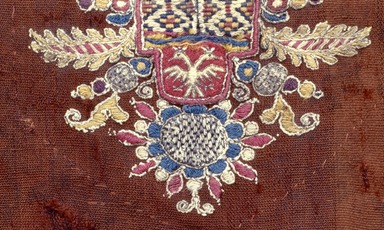
Tunic (Uncu), ca. 17th century. Camelid fiber, silk, metallic thread, 26 3/4 x 31 in. (67.9 x 78.7 cm). Brooklyn Museum, Gift of the Ernest Erickson Foundation, Inc., 86.224.51. Creative Commons-BY (Photo: Brooklyn Museum, 86.224.51_detail05_SL3.jpg)

Tunic (Uncu), ca. 17th century. Camelid fiber, silk, metallic thread, 26 3/4 x 31 in. (67.9 x 78.7 cm). Brooklyn Museum, Gift of the Ernest Erickson Foundation, Inc., 86.224.51. Creative Commons-BY (Photo: Brooklyn Museum, CUR.86.224.51_view01.jpg)
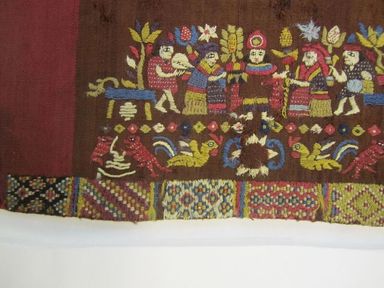
Tunic (Uncu), ca. 17th century. Camelid fiber, silk, metallic thread, 26 3/4 x 31 in. (67.9 x 78.7 cm). Brooklyn Museum, Gift of the Ernest Erickson Foundation, Inc., 86.224.51. Creative Commons-BY (Photo: Brooklyn Museum, CUR.86.224.51_view02.jpg)
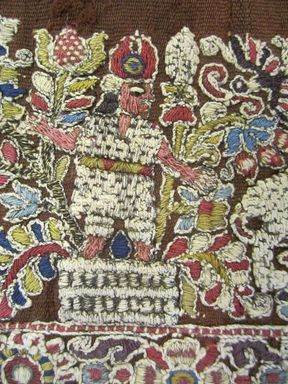
Tunic (Uncu), ca. 17th century. Camelid fiber, silk, metallic thread, 26 3/4 x 31 in. (67.9 x 78.7 cm). Brooklyn Museum, Gift of the Ernest Erickson Foundation, Inc., 86.224.51. Creative Commons-BY (Photo: Brooklyn Museum, CUR.86.224.51_view03.jpg)
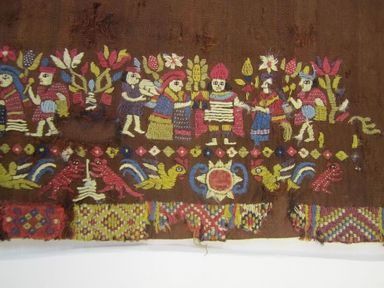
Tunic (Uncu), ca. 17th century. Camelid fiber, silk, metallic thread, 26 3/4 x 31 in. (67.9 x 78.7 cm). Brooklyn Museum, Gift of the Ernest Erickson Foundation, Inc., 86.224.51. Creative Commons-BY (Photo: Brooklyn Museum, CUR.86.224.51_view04.jpg)

Tunic (Uncu), ca. 17th century. Camelid fiber, silk, metallic thread, 26 3/4 x 31 in. (67.9 x 78.7 cm). Brooklyn Museum, Gift of the Ernest Erickson Foundation, Inc., 86.224.51. Creative Commons-BY (Photo: Brooklyn Museum, CUR.86.224.51_view05.jpg)

Tunic (Uncu), ca. 17th century. Camelid fiber, silk, metallic thread, 26 3/4 x 31 in. (67.9 x 78.7 cm). Brooklyn Museum, Gift of the Ernest Erickson Foundation, Inc., 86.224.51. Creative Commons-BY (Photo: Brooklyn Museum, CUR.86.224.51_view06.jpg)
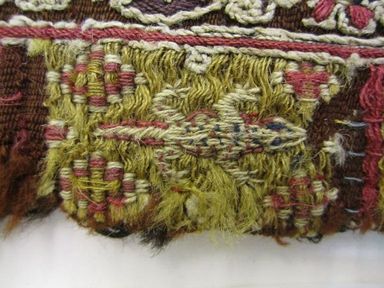
Tunic (Uncu), ca. 17th century. Camelid fiber, silk, metallic thread, 26 3/4 x 31 in. (67.9 x 78.7 cm). Brooklyn Museum, Gift of the Ernest Erickson Foundation, Inc., 86.224.51. Creative Commons-BY (Photo: Brooklyn Museum, CUR.86.224.51_view07.jpg)
Tunic (Uncu)
Arts of the Americas
Este uncu, o túnica de hombre, muestra bandas geométricas adornadas tanto con escudos de estilo europeo y leones rampantes, como con tocapu tradicionales, diseños de rectángulos individuales utilizados sólo por nativos de la más alta élite andina. La incorporación de imaginería y materiales europeos en vestimentas y accesorios tradicionales peruanos era una estrategia común empleada por los indígenas andinos nobles para facilitar la legibilidad de su estatus por parte de los españoles. Este sistema les permitía revindicar los privilegios concedidos por el sistema imperial y preservar elementos de sus tradiciones culturales nativas. En el siglo XVIII, nobles indígenas solían comisionar retratos de cuerpo entero al estilo europeo conocido como Grand Manner, en los cuales a veces llevaban un uncu sobre una camisa de lino y encaje flamenco e incluían también su escudo de armas otorgado por la corona (ver ilustración).


